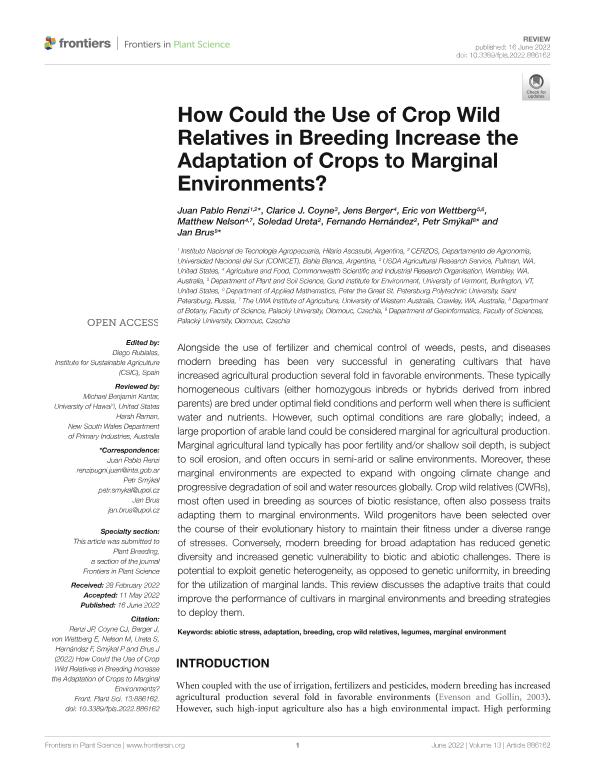Mostrar el registro sencillo del ítem
dc.contributor.author
Renzi, Juan Pablo

dc.contributor.author
Coyne, Clarice J.
dc.contributor.author
Berger, Jens
dc.contributor.author
von Wettberg, Eric
dc.contributor.author
Nelson, Matthew
dc.contributor.author
Ureta, Maria Soledad

dc.contributor.author
Hernández, Fernando

dc.contributor.author
Smýkal, Petr
dc.contributor.author
Brus, Jan
dc.date.available
2023-07-25T15:10:24Z
dc.date.issued
2022-06-16
dc.identifier.citation
Renzi, Juan Pablo; Coyne, Clarice J.; Berger, Jens; von Wettberg, Eric; Nelson, Matthew; et al.; How Could the Use of Crop Wild Relatives in Breeding Increase the Adaptation of Crops to Marginal Environments?; Frontiers Media; Frontiers in Plant Science; 13; 886162; 16-6-2022; 1-21
dc.identifier.uri
http://hdl.handle.net/11336/205344
dc.description.abstract
Alongside the use of fertilizer and chemical control of weeds, pests, and diseases modern breeding has been very successful in generating cultivars that have increased agricultural production several fold in favorable environments. These typically homogeneous cultivars (either homozygous inbreds or hybrids derived from inbred parents) are bred under optimal field conditions and perform well when there is sufficient water and nutrients. However, such optimal conditions are rare globally; indeed, a large proportion of arable land could be considered marginal for agricultural production. Marginal agricultural land typically has poor fertility and/or shallow soil depth, is subject to soil erosion, and often occurs in semi-arid or saline environments. Moreover, these marginal environments are expected to expand with ongoing climate change and progressive degradation of soil and water resources globally. Crop wild relatives (CWRs), most often used in breeding as sources of biotic resistance, often also possess traits adapting them to marginal environments. Wild progenitors have been selected over the course of their evolutionary history to maintain their fitness under a diverse range of stresses. Conversely, modern breeding for broad adaptation has reduced genetic diversity and increased genetic vulnerability to biotic and abiotic challenges. There is potential to exploit genetic heterogeneity, as opposed to genetic uniformity, in breeding for the utilization of marginal lands. This review discusses the adaptive traits that could improve the performance of cultivars in marginal environments and breeding strategies to deploy them.
dc.format
application/pdf
dc.language.iso
eng
dc.publisher
Frontiers Media

dc.rights
info:eu-repo/semantics/openAccess
dc.rights.uri
https://creativecommons.org/licenses/by/2.5/ar/
dc.subject
ABIOTIC STRESS
dc.subject
ADAPTATION
dc.subject
BREEDING
dc.subject
CROP WILD RELATIVES
dc.subject
LEGUMES
dc.subject
MARGINAL ENVIRONMENT
dc.subject.classification
Otras Ciencias Agrícolas

dc.subject.classification
Otras Ciencias Agrícolas

dc.subject.classification
CIENCIAS AGRÍCOLAS

dc.title
How Could the Use of Crop Wild Relatives in Breeding Increase the Adaptation of Crops to Marginal Environments?
dc.type
info:eu-repo/semantics/article
dc.type
info:ar-repo/semantics/artículo
dc.type
info:eu-repo/semantics/publishedVersion
dc.date.updated
2023-07-07T21:28:23Z
dc.identifier.eissn
1664-462X
dc.journal.volume
13
dc.journal.number
886162
dc.journal.pagination
1-21
dc.journal.pais
Suiza

dc.journal.ciudad
Lausanne
dc.description.fil
Fil: Renzi, Juan Pablo. Universidad Nacional del Sur; Argentina. Instituto Nacional de Tecnología Agropecuaria. Centro Regional Buenos Aires Sur. Estación Experimental Agropecuaria Hilario Ascasubi; Argentina
dc.description.fil
Fil: Coyne, Clarice J.. United States Department of Agriculture. Agriculture Research Service; Estados Unidos
dc.description.fil
Fil: Berger, Jens. Commonwealth Scientific And Industrial Research Organisation (csiro);
dc.description.fil
Fil: von Wettberg, Eric. University of Vermont; Estados Unidos. Petersburg Polytechnic University; Rusia
dc.description.fil
Fil: Nelson, Matthew. University of Western Australia; Australia. Commonwealth Scientific And Industrial Research Organisation (csiro);
dc.description.fil
Fil: Ureta, Maria Soledad. Consejo Nacional de Investigaciones Científicas y Técnicas. Centro Científico Tecnológico Conicet - Bahía Blanca. Centro de Recursos Naturales Renovables de la Zona Semiárida. Universidad Nacional del Sur. Centro de Recursos Naturales Renovables de la Zona Semiárida; Argentina. Universidad Nacional del Sur. Departamento de Agronomía; Argentina
dc.description.fil
Fil: Hernández, Fernando. Consejo Nacional de Investigaciones Científicas y Técnicas. Centro Científico Tecnológico Conicet - Bahía Blanca. Centro de Recursos Naturales Renovables de la Zona Semiárida. Universidad Nacional del Sur. Centro de Recursos Naturales Renovables de la Zona Semiárida; Argentina. Universidad Nacional del Sur. Departamento de Agronomía; Argentina
dc.description.fil
Fil: Smýkal, Petr. Palacký University; República Checa
dc.description.fil
Fil: Brus, Jan. Palacký University; República Checa
dc.journal.title
Frontiers in Plant Science
dc.relation.alternativeid
info:eu-repo/semantics/altIdentifier/doi/http://dx.doi.org/10.3389/fpls.2022.886162
dc.relation.alternativeid
info:eu-repo/semantics/altIdentifier/url/https://www.frontiersin.org/articles/10.3389/fpls.2022.886162/full
Archivos asociados
